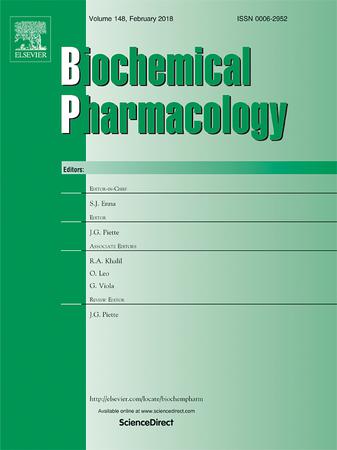海洋生物碱Ascomylactam A体外和体内抗MRSA多靶点机制及抗生素协同作用。
IF 5.3
2区 医学
Q1 PHARMACOLOGY & PHARMACY
引用次数: 0
摘要
耐甲氧西林金黄色葡萄球菌(MRSA)是一种多重耐药细菌,经常引起严重的卫生感染问题。海洋真菌被视为抗生素先导化合物的一个有希望的来源。本研究对海洋真菌Microascus sp. SCSIO 41821中提取的生物碱Ascomylactam A (AsA)的体内外抑菌活性、增效作用及机制进行了研究。抑菌试验表明,AsA对MRSA SC41993具有良好的抑菌活性和抑制生物膜的形成,与临床抗生素具有协同抑菌作用。转录组学揭示了AsA通过LytSR、VraSR、ArgAC和KdpDE双组分系统(TCS)影响MRSA生物膜形成、细胞壁合成和毒力的潜在机制。此外,通过AsA处理,发现AdhE蛋白是MRSA氧化应激和脂质过氧化的潜在靶点,并通过调节部分基因逆转MRSA的耐药性。体内实验表明,AsA联合硫酸庆大霉素(GMS)对临床MRSA USA300的治疗效果优于单用,尤其是对心脏的治疗效果更好。本研究对十氢芴类生物碱的抗菌机制进行了初步研究,支持AsA作为一种有前景的治疗AsA感染的药物的潜力。本文章由计算机程序翻译,如有差异,请以英文原文为准。

Multi-target anti-MRSA mechanism and antibiotic synergistic effect of marine alkaloid Ascomylactam A in vitro and in vivo against clinical MRSA strains
Methicillin-resistant Staphylococcus aureus (MRSA), as a kind of multi-drug resistant bacteria, often causes serious sanitary infection problems. Marine fungi are seen as a promising source of lead compounds for antibiotics. In this research, the antibacterial activity, antibiotic synergistic effect and mechanism of the alkaloid Ascomylactam A (AsA) derived from the marine fungus Microascus sp. SCSIO 41821 were investigated in vivo and in vitro. Antibacterial assays showed that AsA had excellent antibacterial activity and inhibition of biofilm formation against MRSA SC41993, and exhibitted synergistic antibacterial effects with clinical antibiotics. Transcriptomics revealed the potential mechanism that AsA affected the formation of MRSA biofilm, cell wall synthesis and virulence through LytSR, VraSR, ArgAC and KdpDE two-component system (TCS). In addition, by treatment with AsA, it was found that AdhE protein was a potential target for oxidative stress and lipid peroxidation in MRSA, and the resistance of MRSA was reversed by regulating some genes. In vivo experiments showed that AsA combined with gentamicin sulfate (GMS) had a better therapeutic effect than alone against clinical MRSA USA300, especially in the heart. In this study, the antibacterial mechanism of decahydrofluorene-class alkaloids was preliminarily investigated, supporting the potence of AsA as a promising therapeutic agent to combat MASA infections.
求助全文
通过发布文献求助,成功后即可免费获取论文全文。
去求助
来源期刊

Biochemical pharmacology
医学-药学
CiteScore
10.30
自引率
1.70%
发文量
420
审稿时长
17 days
期刊介绍:
Biochemical Pharmacology publishes original research findings, Commentaries and review articles related to the elucidation of cellular and tissue function(s) at the biochemical and molecular levels, the modification of cellular phenotype(s) by genetic, transcriptional/translational or drug/compound-induced modifications, as well as the pharmacodynamics and pharmacokinetics of xenobiotics and drugs, the latter including both small molecules and biologics.
The journal''s target audience includes scientists engaged in the identification and study of the mechanisms of action of xenobiotics, biologics and drugs and in the drug discovery and development process.
All areas of cellular biology and cellular, tissue/organ and whole animal pharmacology fall within the scope of the journal. Drug classes covered include anti-infectives, anti-inflammatory agents, chemotherapeutics, cardiovascular, endocrinological, immunological, metabolic, neurological and psychiatric drugs, as well as research on drug metabolism and kinetics. While medicinal chemistry is a topic of complimentary interest, manuscripts in this area must contain sufficient biological data to characterize pharmacologically the compounds reported. Submissions describing work focused predominately on chemical synthesis and molecular modeling will not be considered for review.
While particular emphasis is placed on reporting the results of molecular and biochemical studies, research involving the use of tissue and animal models of human pathophysiology and toxicology is of interest to the extent that it helps define drug mechanisms of action, safety and efficacy.
 求助内容:
求助内容: 应助结果提醒方式:
应助结果提醒方式:


